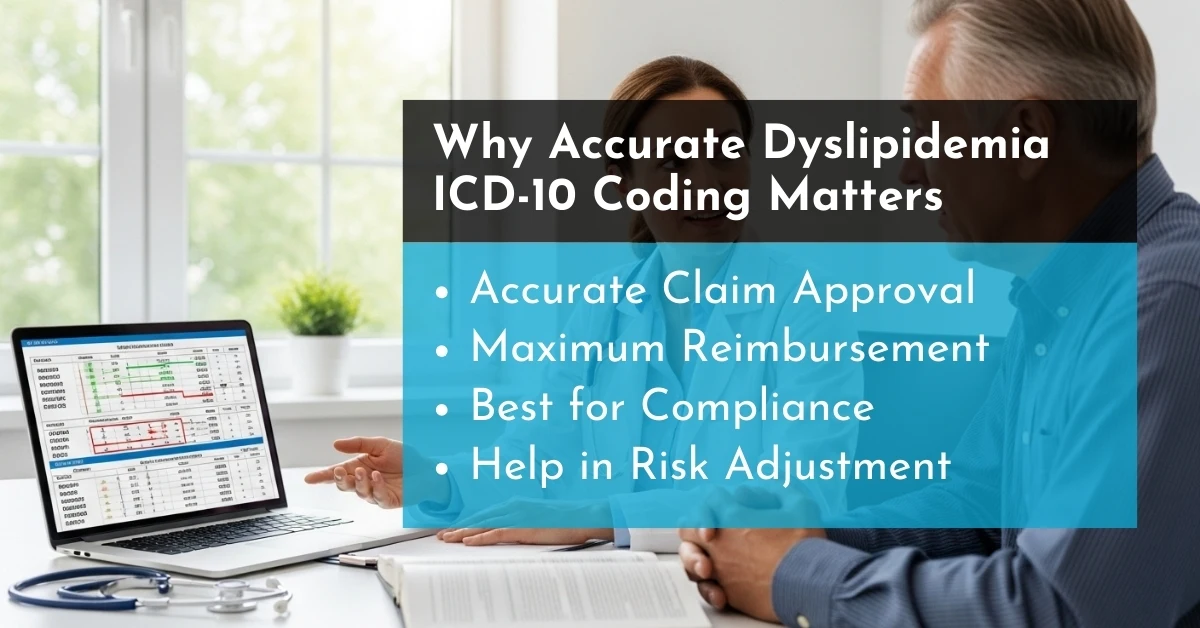Proper coding of dyslipidemia, which is a condition that leads to abnormal lipid levels in blood, is essential in healthcare in diagnosis coding and the effective subsequent billing and reimbursement. Dyslipidemia is strongly linked with cardiovascular disease, stroke, and diabetes mellitus; hence, it is very critical that healthcare practitioners effectively report this disorder.
This comprehensive guide will discuss the ICD-10 code for dyslipidemia and its variations, including coding for unspecified dyslipidemia, mixed dyslipidemia, and diabetes-related dyslipidemia.
Dyslipidemia refers to abnormal levels of lipids (fats) in the blood, including cholesterol and triglycerides. These imbalances may involve:
In medical terms, dyslipidemia is a risk factor for atherosclerosis, heart attack and stroke. When coders and billing teams utilize the right dyslipidemia ICD-10 code, providers will receive the appropriate reimbursement and will not have to wait too long before claims are processed.
The official ICD-10-CM code for dyslipidemia is:
This code is widely used when the provider documents “dyslipidemia” without additional details. It covers cases where lipid abnormalities are present, but the exact type (cholesterol vs triglycerides) is not specified.
When there is no detailed description in the medical documentation, coders must assign the ICD-10 code for dyslipidemia unspecified (E78.5).
Examples include:
Relevant keywords:
While this code is commonly used, providers should be encouraged to document more detail whenever possible. More specific coding supports better reimbursement and accurate risk adjustment.
When a patient has multiple lipid abnormalities, such as high cholesterol and high triglycerides, the correct ICD-10 entry is:
This is the official mixed dyslipidemia ICD-10 code.
Accurate documentation of mixed dyslipidemia is especially important in:
Coding E78.2 instead of E78.5 reflects the true complexity of the condition and may influence payer risk adjustment models.
To avoid denials, coders should know the full range of dyslipidemia ICD-10 codes beyond E78.5 and E78.2:
ICD-10 Code | Description | When to Use |
E78.0 | Pure hypercholesterolemia | Isolated LDL elevation without triglyceride abnormality |
E78.1 | Pure hyperglyceridemia | Isolated triglyceride elevation |
E78.71 | Elevated lipoprotein(a) [Lp(a)] | When documented in labs; emerging cardiovascular risk marker |
E78.72 | Elevated LDL cholesterol | When specifically documented as high LDL without mixed disorder |
Note: Using E78.0, E78.1, E78.71, and E78.72 ensures coding precision, reduces denials, and strengthens documentation for payer review.
Dyslipidemia frequently occurs as a complication of Type 2 diabetes mellitus. In such cases, coders must use both a diabetes code and a dyslipidemia code.
Example:
If a provider documents “Type 2 diabetes with dyslipidemia,” coders should report E11.69 + E78.5.
This dual coding is critical for:
The Importance of Accurate Dyslipidemia ICD-10 Coding in Medical Billing: Ensuring proper coding not only supports accurate claim submission and timely reimbursements but also minimises denials, enhances compliance with payer regulations, and improves the overall quality of patient care documentation. Here are some of the uses:
Mistakes, like coding the wrong code, omitting a diabetes complication, or excessive use of unspecified dyslipidemia ICD-10 codes, can result in expensive denials.

Even if the correct ICD-10 code is used, claims may still be denied if the provider is not credentialed with the payer. Credentialing ensures providers can bill for services such as:
Credentialing also ensures compliance with Medicare, Medicaid, and commercial insurance requirements, allowing providers to avoid delays in payment. For practices managing chronic conditions like dyslipidemia, proper credentialing is essential for smooth revenue cycle management (RCM).
Without proper payer enrollment, even correctly coded claims (E78.5, E78.2) may face rejection.
To minimize denials, coders and providers should follow these strategies:
Failure to obtain prior authorisation for lipid panels or advanced lipid testing often leads to payer denials. Our prior authorisation services streamline approvals and protect revenue.
We at Hello MDs provide medical care support based on proper coding, billing, and credentialing. In such cases as dyslipidemia, we can offer services:
Through our partnership, providers will avoid claim denials, maximize reimbursements, and decrease administrative requirements to have more time to focus on patient care.
Hello MDs provides end-to-end medical billing services and tailored physician billing solutions that maximize claim acceptance for lipid disorder management.
Dyslipidemia ICD-10 coding is more than diagnosis documentation; it directly affects claim approvals, HCC scoring, and audit readiness. Coders and providers must use specific ICD-10 codes (E78.0–E78.72), align with CPT testing, and document clinical links to diabetes when applicable. By improving coding accuracy, healthcare organisations strengthen compliance and optimise reimbursement.
In Hello MDs, our team can assist you in case your practice is experiencing problems with the denials of claims or enrollment with the payer. Reach out to us today and have professional assistance in medical billing, credentialing, and ICD-10 coding of dyslipidemia and other chronic diseases.
Disclaimer:
This content is for educational and informational purposes only and does not replace professional medical or coding advice.
Some images in this blog may be AI-generated or for illustrative purposes only.
The code in ICD-10 of dyslipidemia is E78.5- Dyslipidemia, unspecified.
The code is E78.2- Mixed hyperlipidemia.
Enter E11.69 (Type 2 diabetes with other specified complication) and E78.x to enter dyslipidemia.
Not exactly. Dyslipidemia is any lipid abnormality, whereas hyperlipidemia tends to imply increased lipids.
It averts denials, promotes compliance, helps in HCC coding, and optimises reimbursement.
80061 (lipid panel) is the most common. Specialized tests may use 83700-83704 or 81400-81408.